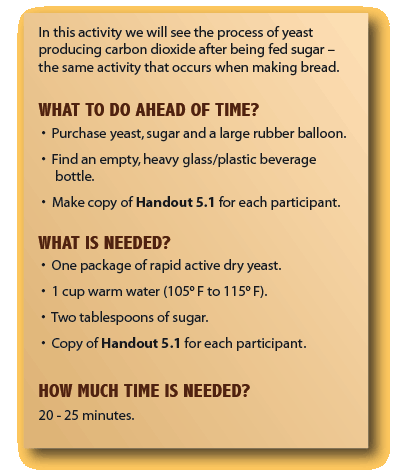
Activity 5.1: Balloons, Bottles and Bread
Directions
1. Before beginning the activity, stretch the balloon out by blowing it up several times and then releasing the air.
2. Add entire packet of yeast and sugar to cup of warm water and stir until sugar is dissolved.
3. Pour mixture into bottle.
4. Attach balloon to top of bottle, making sure bottle is sealed tightly.
5. After several minutes, observe the balloon. If nothing happens right away, wait longer.
Discussion
Nearly 10,000 years ago, humans began using one-celled organisms to make bread. In bread-making the organisms, yeast, are provided with sugars which they can break down. As they consume the sugar, they produce alcohol, which contributes to the aroma of baking bread, and carbon dioxide, which makes the dough rise and form a honeycomb texture.
In this activity the yeast feeds on sugar and produces carbon dioxide. With no place to go but up, this gas slowly fills the balloon. A very similar process happens as bread rises. Carbon dioxide made by the yeast has no place to go and expands the network made by the proteins in the wheat flour to form thousands of balloon-like bubbles. Bubbles gives the bread its “holey” texture.
- What do you think would happen if we substituted salt for the sugar?
- Describe what might happen if you used cold water instead of warm water.
When participants finish discussion, ask them to complete Handout 5.1.
Next: Activity 5.2: Birth of Baby Corn (optional)